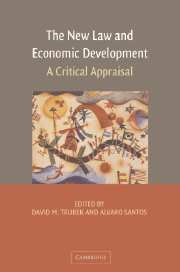Book contents
- Frontmatter
- Contents
- Contributors
- 1 Introduction: The Third Moment in Law and Development Theory and the Emergence of a New Critical Practice
- 2 Three Globalizations of Law and Legal Thought: 1850–2000
- 3 The “Rule of Law” in Development Assistance: Past, Present, and Future
- 4 The “Rule of Law,” Political Choices, and Development Common Sense
- 5 The Dialectics of Law and Development
- 6 The Future of Law and Development: Second-Generation Reforms and the Incorporation of the Social
- 7 The World Bank's Uses of the “Rule of Law” Promise in Economic Development
- Index
2 - Three Globalizations of Law and Legal Thought: 1850–2000
Published online by Cambridge University Press: 06 July 2010
- Frontmatter
- Contents
- Contributors
- 1 Introduction: The Third Moment in Law and Development Theory and the Emergence of a New Critical Practice
- 2 Three Globalizations of Law and Legal Thought: 1850–2000
- 3 The “Rule of Law” in Development Assistance: Past, Present, and Future
- 4 The “Rule of Law,” Political Choices, and Development Common Sense
- 5 The Dialectics of Law and Development
- 6 The Future of Law and Development: Second-Generation Reforms and the Incorporation of the Social
- 7 The World Bank's Uses of the “Rule of Law” Promise in Economic Development
- Index
Summary
The study of law and development began with a particular positioning of its two terms, “law” in relation to “development.” The question was how legal reform might contribute to the takeoff into self-sustaining growth in the Cold War, postcolonial Third World of the 1960s. Trubek and Galanter's famous article, “Scholars in Self Estrangement,” published in 1974, stands, among other things, for the repositioning of the two terms, problematizing the relatively simple instrumental idea of law with which the field had begun, and politicizing our understanding of development. I hope this essay will contribute to the renewal of the project that this book represents.
The three globalizations of my title refer to two overlapping periods of legal institutional and conceptual change in the West: to the rise of Classical Legal Thought between 1850 and 1914, and of socially oriented legal thought between 1900 and 1968; and to the transformation of the characteristic traits of the two periods in two distinct processes of diffusion across the world of colonies and recently independent nation states. The briefer third part sketches a similar institutional and legal theoretical development – a third globalization – for the period 1945–2000 (for a summary overview, see Table 1).
These institutional and conceptual transformations might be described as one of the frameworks or contexts for what development did or did not occur in the world beyond the industrial West over these 150 years. But framework and context are misleading terms for describing the relationship between legal and economic activities.
- Type
- Chapter
- Information
- The New Law and Economic DevelopmentA Critical Appraisal, pp. 19 - 73Publisher: Cambridge University PressPrint publication year: 2006
- 139
- Cited by

